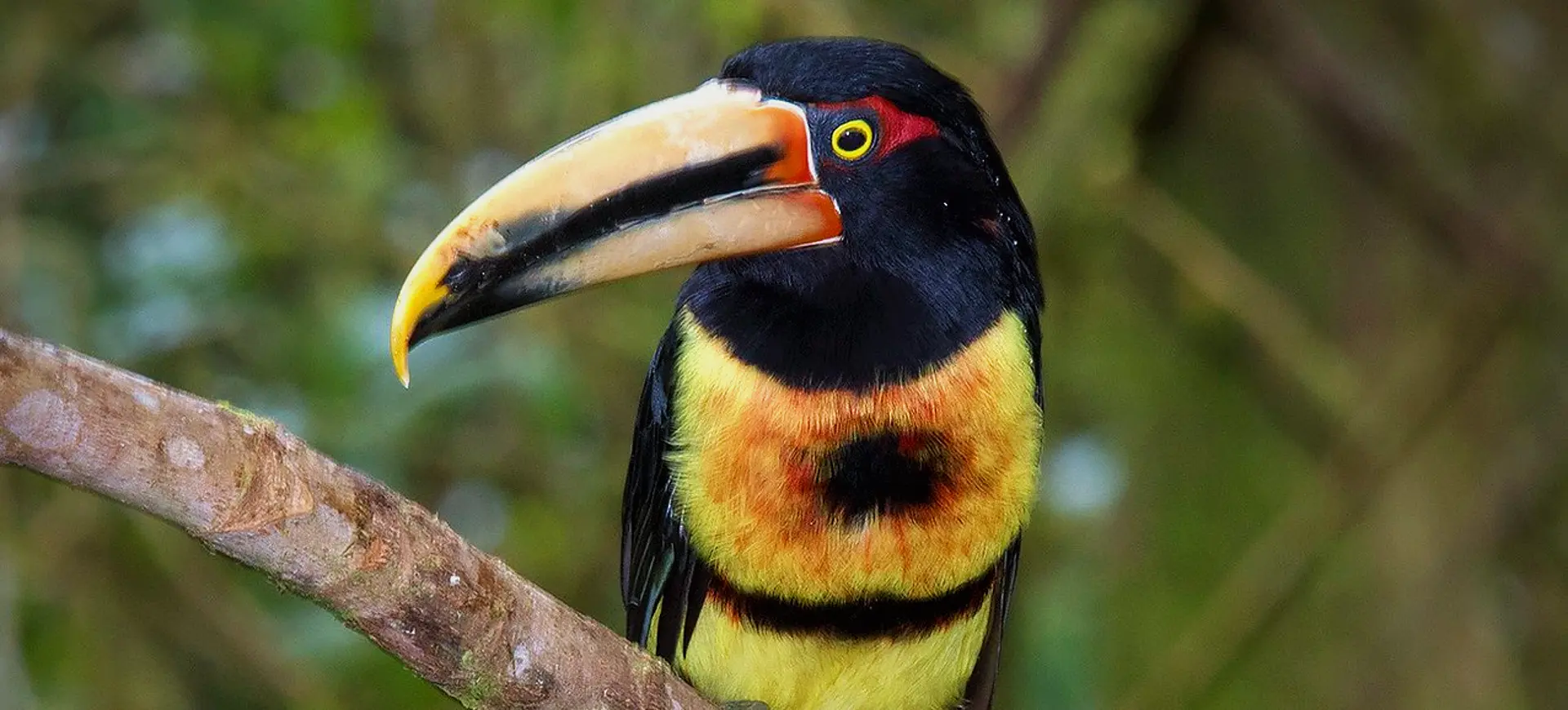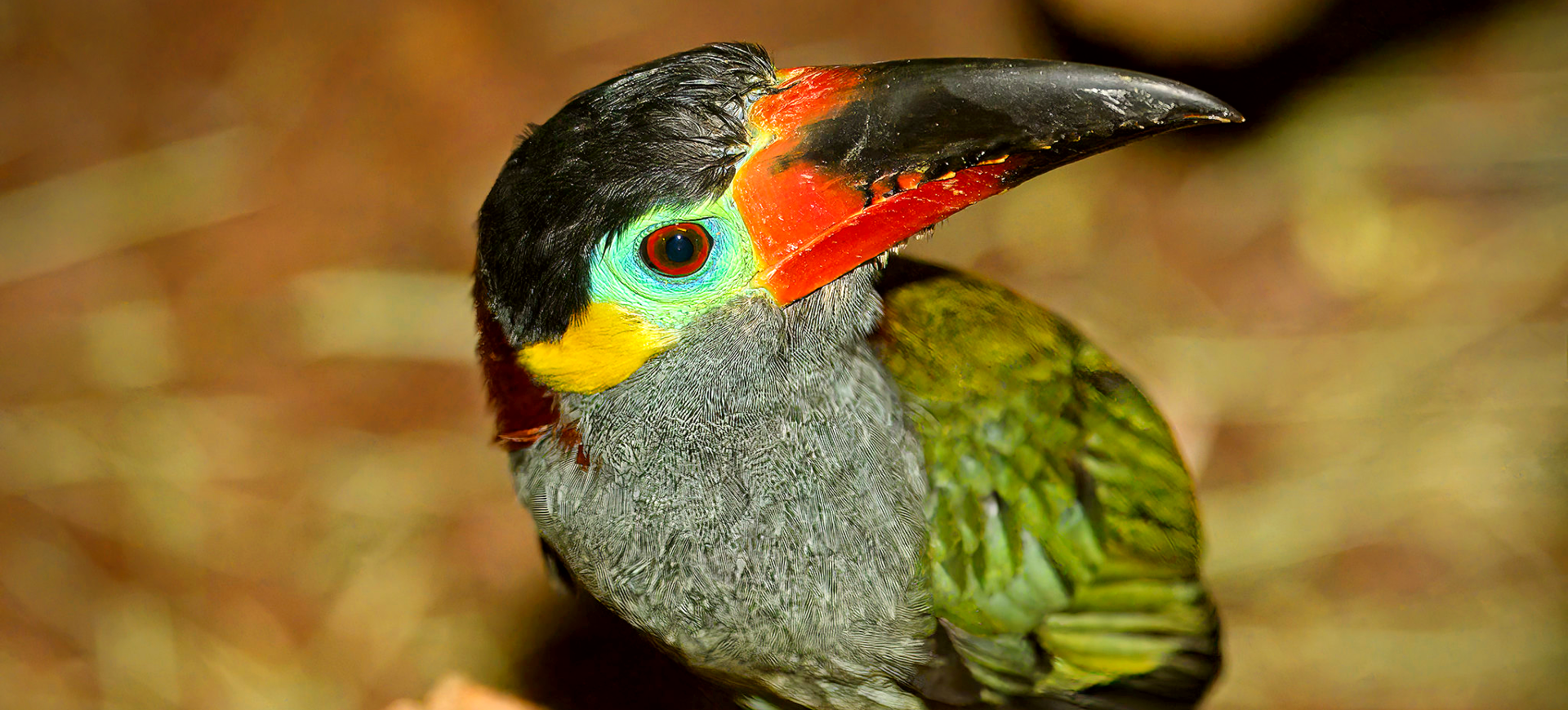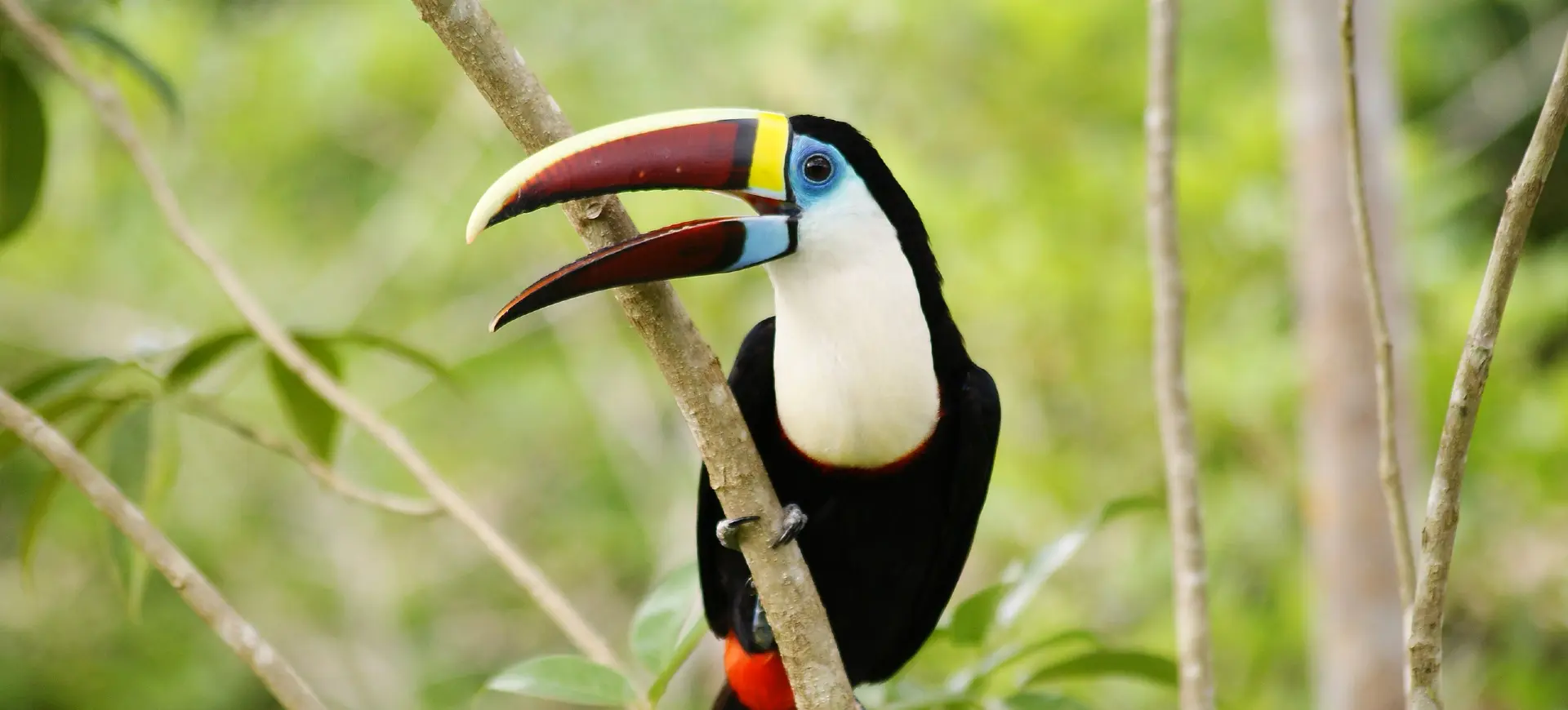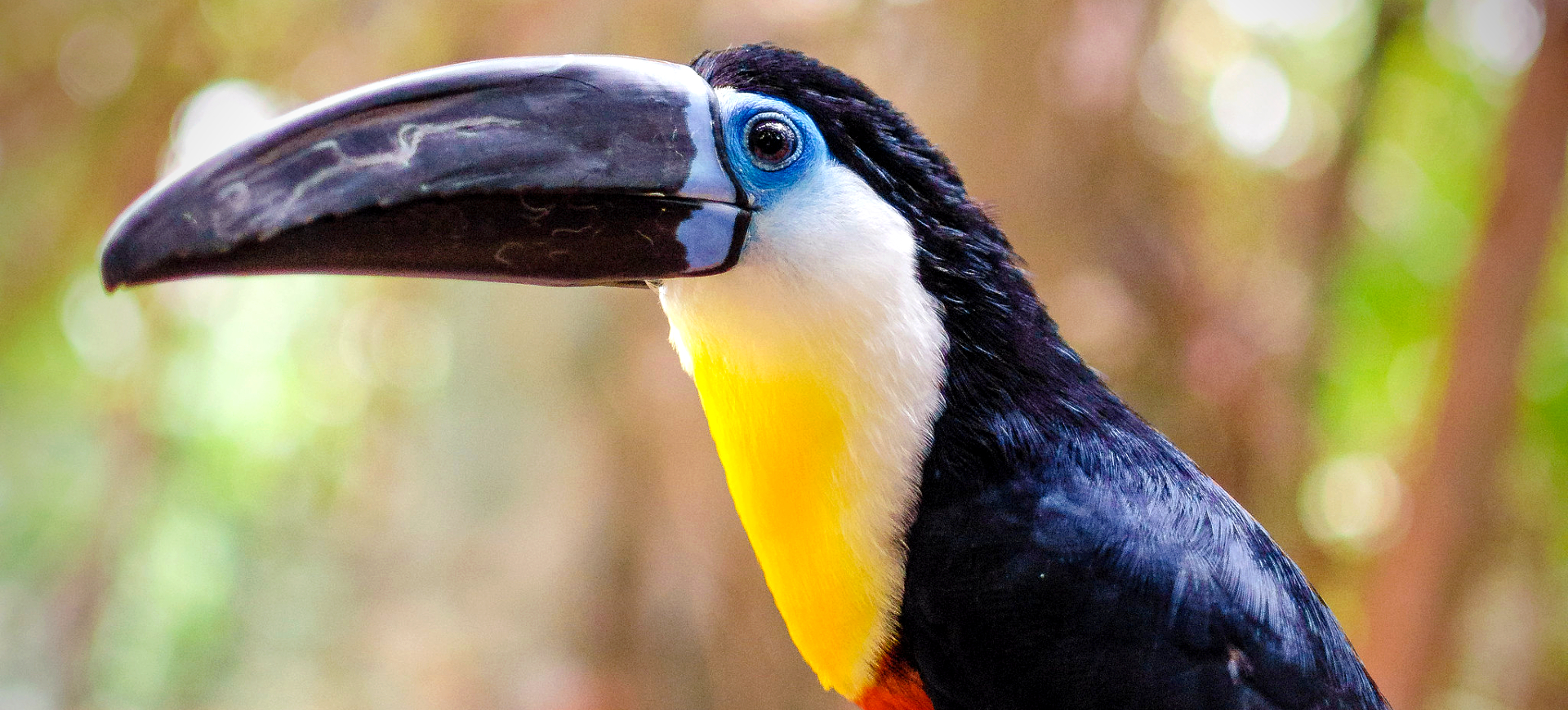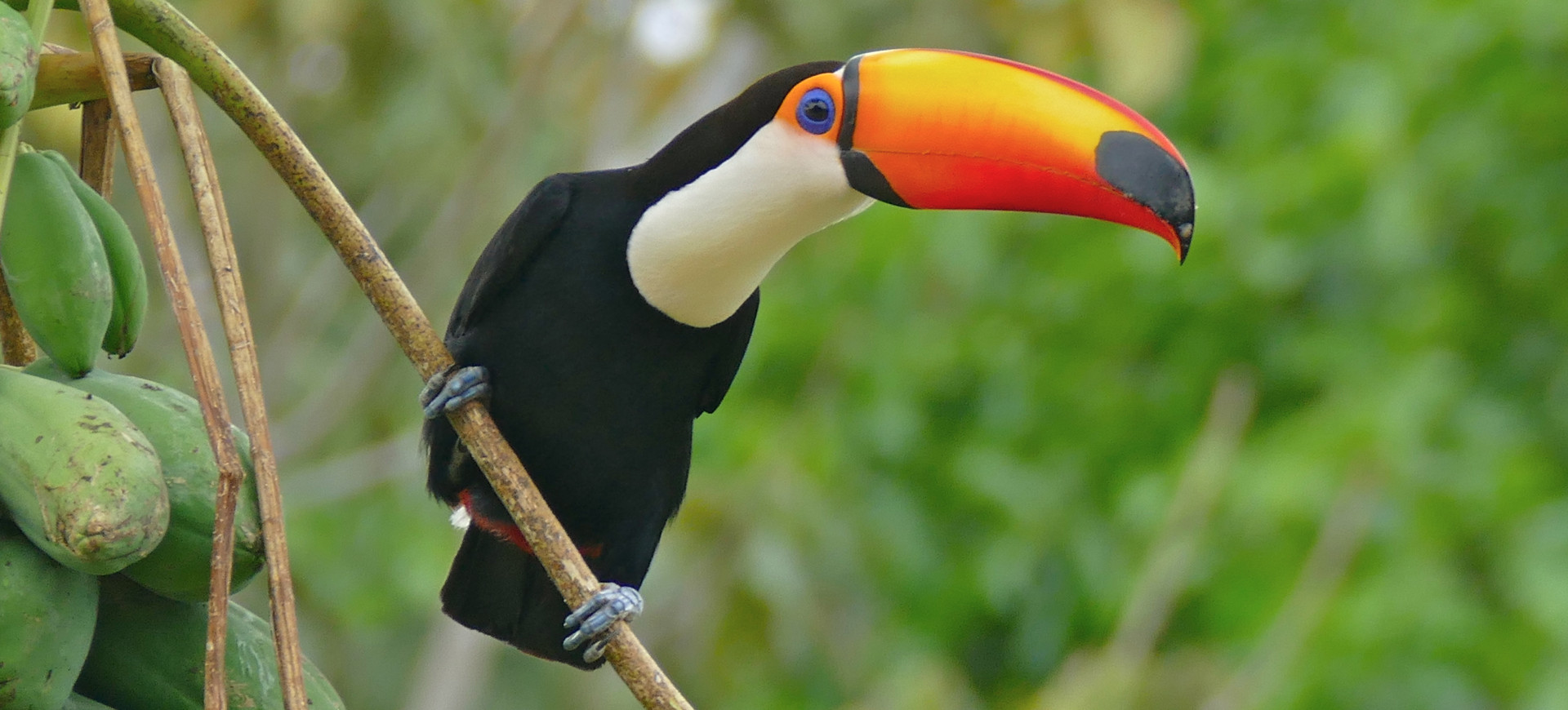Overview
The Curl-crested Araçari is a striking bird known for its distinctive appearance and behavior. It belongs to the toucan family and is smaller than its more famous relatives. This species is characterized by its vibrant plumage, which includes a black body, a yellow underbelly with a red spot, and a large, colorful bill. The most notable feature of the Curl-crested Araçari is its unique curly crest, made up of modified feather shafts.
Native to South America, the Curl-crested Araçari inhabits the tropical rainforests of the Amazon basin. It is predominantly found in the lowland forests but can also be seen in wooded habitats near rivers and clearings. The Araçari is an arboreal bird that spends most of its time in the treetops. It is known for its playful and friendly nature and is often seen in small groups.
The Curl-crested Araçari’s diet mainly consists of fruits and consumes insects, eggs, and small vertebrates. This varied diet is crucial in seed dispersal within its habitat, aiding forest regeneration. Its foraging behavior is agile, moving quickly through the trees using its strong bill to gather food.
Taxonomy
Kingdom
Phylum
Class
Order
Family
Genus
Species
Type
Physical Description:
The Curl-crested Araçari is a medium-sized bird known for its vibrant and colorful appearance. Its most distinguishing feature is the curly crest on its head, which consists of glossy black feathers that curl upward. The bird’s bill is large and serrated, ideal for foraging, with a striking yellow, orange, and black pattern. The plumage is primarily black with a bright yellow underbelly and a red rump, making it visually striking in its natural habitat.
The bird’s size and build are adapted for an arboreal lifestyle. Its strong, zygodactyl feet (two toes facing forward and two backward) allow it to grip branches securely. The Curl-crested Araçari’s wings are short and rounded, suited for quick, darting flights through the forest canopy. Despite its bulky bill, the bird is an agile mover, easily navigating the treetops.

Lifespan: Wild: ~10 Years || Captivity: ~18 Years

Weight: Male: 6.2-9.9 oz (175-280 g) || Female: 5.8-9.1 oz (165-258 g)

Length: Male & Female: 15-17 inches (38-43 cm)
Characteristic:
Native Habitat:
The Curl-crested Araçari is native to the tropical rainforests of South America. Its habitat primarily includes the Amazon basin, encompassing areas rich in biodiversity and dense vegetation. The bird is particularly adapted to living in the canopy layer of the forest, where it finds most of its food and shelter.
The species thrives in areas with abundant fruiting trees, which constitute the major part of its diet. It is also found in secondary forests and edges of clearings, adapting to slightly altered landscapes. The Araçari’s dependence on forested areas makes it vulnerable to habitat destruction and deforestation.
Climate Zones:
Biomes:
WWF Biomes:
Biogeographical Realms:
Continents:
Diet:
Diet & Feeding Habits:
The Curl-crested Araçari is an omnivore that primarily feeds on various fruits. It plays a significant role in its ecosystem as a seed disperser, aiding in the propagation of numerous tree species. The bird uses its long, curved bill to pluck fruits from trees and also to forage for insects, small reptiles, and bird eggs.
In addition to fruits and insects, the Araçari occasionally feeds on small vertebrates, such as lizards and nestlings. Its feeding habits are both opportunistic and seasonal, depending on the availability of food sources in its habitat. The bird is also known to visit bird feeders in areas where it coexists with humans.
Mating Behavior:
Mating Description:
The Curl-crested Araçari is a socially monogamous bird, forming pairs during the breeding season. The courtship involves mutual feeding and vocalizations, with both males and females participating actively. Nesting typically occurs in tree cavities, which the birds find or usurp from other species. The pair works together to prepare the nest, often using wood chips to line the cavity.
The female lays between two to four eggs, which both parents incubate. During this time, the male plays a significant role in feeding the female and protecting the nest. The chicks are altricial, born blind and featherless, requiring intensive care from both parents. The family stays together for some time after the chicks fledge, with the offspring learning foraging and social behaviors.
Reproduction Season:
Birth Type:
Pregnancy Duration:
Female Name:
Male Name:
Baby Name:
Social Structure Description:
The Curl-crested Araçari is a social bird, often seen in small groups of up to six individuals. These groups typically consist of family units or loosely associated individuals. The bird’s social behavior includes playful interactions, mutual preening, communal roosting, and strengthening social bonds.
During the breeding season, the Araçari’s social structure centers around the family unit. Both parents are involved in raising the offspring, demonstrating high parental care. Outside of the breeding season, the birds may join larger mixed-species flocks, interacting with other bird species in their habitat.
Groups:
Conservation Status:
Population Trend:
The Curl-crested Araçari’s wild population is considered stable, with no significant trends indicating a decline. The bird is relatively common within its range, especially in undisturbed areas of the Amazon rainforest. Its adaptability to various forest habitats contributes to the stability of its population.
Despite being listed as Least Concern, the Araçari faces habitat loss and fragmentation threats due to deforestation. The bird’s reliance on dense forest cover for food and nesting makes it sensitive to environmental changes. Conservation efforts to preserve its natural habitat are crucial for maintaining its population in the wild.
Population Threats:
The primary threat to the Curl-crested Araçari is habitat loss due to deforestation and land conversion for agriculture and logging. Reducing forest cover directly impacts the bird’s food sources and nesting sites. Habitat fragmentation can also isolate populations, affecting genetic diversity and breeding success.
Another threat includes the illegal pet trade, as the Araçari’s attractive appearance makes it a target for bird collectors. While not as heavily impacted as other species, this trade can lead to localized population declines. Climate change also poses a long-term threat, potentially altering the bird’s habitat and food availability.
Conservation Efforts:
Conservation efforts for the Curl-crested Araçari primarily focus on habitat preservation and sustainable land-use practices. Protecting large areas of tropical rainforest is crucial for maintaining the bird’s natural habitat. The involvement of local communities in conservation initiatives is also essential, promoting awareness and sustainable practices.
Several countries within its range also have legal protections regulating trade and hunting. Efforts by wildlife organizations and governments aim to monitor the species’ population and habitat conditions. Research into the bird’s ecology and behavior contributes to better conservation planning and strategies.
Additional Resources:
Fun Facts
- The Curl-crested Araçari’s curly crest is unique among toucans and is made of feathers with modified shafts.
- Despite their large, cumbersome-looking bills, Araçaris are very agile in their movements.
- They play a vital role in the ecosystem as seed dispersers, aiding forest regeneration.
- The Araçari’s tongue is long, narrow, and frayed at the end, adapted for fruit-eating.
- These birds are known for their playful nature, often engaging in mock fights and cooperative play.
- Its colorful bill is not just a visual feature; it’s lightweight and an effective tool for foraging.
- This bird is a vital seed disperser in its ecosystem, contributing to the growth of various fruit trees in the rainforest.
- It exhibits a playful nature, often engaging in social interactions with other members of its species.
- Despite its seemingly cumbersome bill, the Araçari can traverse through dense forest canopies with remarkable agility.
- They bathe in the rain, shaking their bodies and fluttering their wings to clean themselves.





